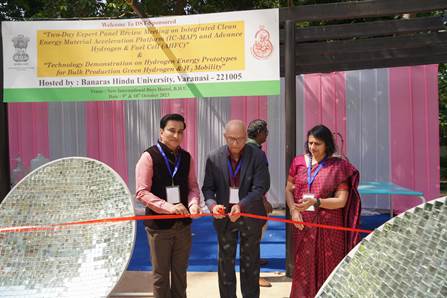Cutting-Edge Quantum Technology Unveiled for Green Hydrogen Production, Paving the Way for a Sustainable Future

In a remarkable stride towards a greener future, a groundbreaking quantum technology has been introduced to revolutionize green hydrogen production on a large scale. Developed by the Green Keplerate Team at Banaras Hindu University, this quantum-powered innovation has the potential to significantly boost green hydrogen production.
The unveiling of this pioneering technology took place at the university in Varanasi, with the inauguration ceremony graced by Dr. Anita Gupta, Head of the Climate Change & Clean Energy Division, DST, along with Dr. Ranjith Krishna Pai, Scientist & Director of Climate Change & Clean Energy Division, DST, and Prof. R. R. Sonde, Chairman of the expert committee at IIT Delhi. The event gathered domain experts from across the country.
The technology, engineered by the team led by Dr. Somenath Garai and Prof. S. Srikrishna, highlights the remarkable potential of green hydrogen as an eco-friendly energy alternative. It introduces a next-generation quantum-powered photo-catalyst featuring a charge transfer system with exceptional proton availability and mobility. This technological advancement opens new doors for quantum catalytic applications in energy generation.
The patent application for this transformative technology, operating under the project titled “Boosting the H2 Economy by Harnessing the Merits of Quantum Encapsulation Chemistry: Augmented Kinetics for Water Splitting Reaction Under Confinement” within the Hydrogen and Fuel Cell program of the Clean Energy Research Initiative, is currently pending.
At the core of this state-of-the-art technology is a photochemical-reactor design with integrated illumination and external concave reflective panels, optimizing solar energy absorption. The Green Keplerate Team has engineered a continuous electron-coupled proton supply system, utilizing industrial metal waste in an electron injector mechanism. After meticulous refinements, the laboratory-scale production of green hydrogen reached a remarkable peak rate of approximately 1 liter per minute for every 10 grams of Quantum Photocatalysts.
One of the key advantages of this innovative technology is the high purity of the hydrogen gas it produces, eliminating the need for additional purification processes. This cost-effective solution has the potential to be applied across various sectors, spanning energy production, transportation, and agriculture.
As part of an ongoing project funded by the DST, the Green Keplerate Team has also envisioned storage-free direct hydrogen internal combustion engine technologies. These innovations have been successfully demonstrated on automobiles with a wide range of engine capacities and functionalities, presenting promising possibilities for sustainable mobility solutions.





